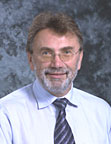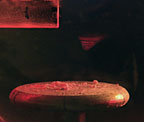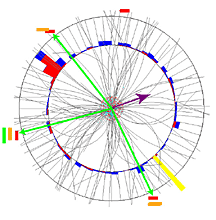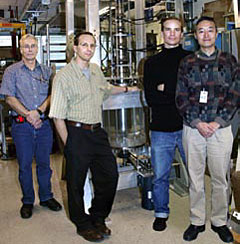Research
Highlights...
|
 |
| Number 178 |
February 28, 2005 |
|
Breathing easy
|
A visual representation of how harmful agents are destroyed by the plasma technology. |
Researchers at DOE's Pacific Northwest National Laboratory are using the universe's most common form of matter—plasma—in a new filtration system that may one day save the lives of people seeking shelter from chemical or biological attacks. Originally designed for the Department of Defense to protect soldiers, PNNL's Hybrid Plasma Filtration System may soon find its way into buildings, tented structures and aircraft. PNNL's filtration system is unlike any other because it doesn't use common High Efficiency Particulate Air, or HEPA, filters. Instead, researchers found that by using plasma to destroy airborne contaminants that come through the filters, they actually lasted much longer, making the system more reliable and less cumbersome to operate. The PNNL-developed system is able to destroy both biological and chemical contaminants including toxic industrial chemicals, such as hydrogen cyanide and hydrochloric acid, and chemical warfare agents, such as sarin, which was released in a 1995 terrorist attack in the Tokyo subway.
[Andrea Turner, 509/375-3893,
andrea.turner@pnl.gov]
|
|
Robotic aircraft tested as firefighting tool
National Aeronautics and Space Administration representatives are working with DOE's Idaho National Laboratory engineers to test unmanned aerial vehicles as part of a NASA-sponsored program to evaluate potential fire-fighting support from small robotic planes. Today's big fires are mapped using manned aircraft, fitted with thermal sensors that fly at night over hot spots and fire perimeters. NASA and INL engineers are investigating whether it makes sense to use flocks of small, inexpensive UAVs carrying a variety of sensors for such routine surveillance. NASA, INL and Forest Service engineers are looking for technologies that are reliable, user-friendly, and either improve the speed and safety, or decrease the cost of firefighting.
[Kathleen Gatens, 208/526-1058,
Kathleen.Gatens@inl.gov]
|
|
New detector could thwart nuclear smugglers
Scientists at DOE's Los Alamos National Laboratory have developed a detector to see through lead or other heavy shielding in truck trailers or cargo containers and detect uranium, plutonium or other similar materials. The technique, called muon radiography, uses the cosmic rays that constantly bombard Earth and is far more sensitive than the x-ray or gamma ray detectors now in use. Detectors above and another pair beneath a truck or cargo container record each muon's path before and after it passes through the cargo. By analyzing changes in energy and trajectory, computers build a three-dimensional mathematical map of dense items in the cargo.
[Jim Danneskiold, 505/667-1640,
slinger@lanl.gov]
|
|
Following nature's lead
Those seeking to design more efficient catalysts might do well to look at how chemistry works in nature. Brookhaven Lab scientists have identified a bacterial enzyme with a catalytic complex that their theoretical calculations predict should be four to five times more reactive than catalysts currently used for producing hydrogen and controlling air pollutants. Next they'll see if they can use the enzyme itself, or synthesize a mimic of its reactive center—an engineering feat on the nanoscale. Once they have the nanoparticles, the scientists will test their reactivity to see if the “naturally” engineered catalyst works as well as theory predicts.
[Karen McNulty Walsh, 631/344-8350,
kmcnulty@bnl.gov]
|
|
DZero delves into diboson data developments
|
End-on view of one of three WZ events. The collision occurred at the center of the detector. A Z boson decayed to two muons (two of the green tracks). A W boson candidate decayed to a muon and a neutrino (a green track and purple arrow opposite to it). Other lower energy charged-particles were produced in the collision and are represented as grey tracks. The straighter the track, the more energetic the particle. The red and blue towers in between the dark circles represent energy deposited in DZero calorimeter by the particles created in the collisions. |
The Tevatron collider at DOE's Fermilab is the only particle accelerator in the world that could ever produce both W and Z bosons, which carry the weak force, in the same collision. The W boson is 85 times the mass of a proton; the Z is even more massive. The W and Z quickly disintegrate into lighter particles, which are spotted in the DZero detector. DZero scoured approximately 14 trillion collisions produced between April 2002 and June 2004, finding three events containing both a W and a Z. With these three candidates, DZero is able to estimate the rate the Tevatron produces W-Z events, and set constraints on the strength of the interaction between the W and Z.
[Mike Perricone,
630/840-5678,
mikep@fnal.gov]
|
|
Fleshing out the genome
A consortium led by Seattle-area nonprofit research center BIATECH and DOE's Pacific Northwest National Laboratory has come up with a powerful new proteomics and bioinformatics method that integrates experimental and computational analyses to ascribe function to genes that had been termed “hypothetical”— sequences that appear in the genome but whose biological purpose were previously unknown. The method not only portends a way to fill in the blanks in any organism's genome but also to compare the genomes of different organisms and their evolutionary relationship. The group described its technique, applied to the toxic-metal-reducing microbe Shewanella oneidensis, in the Feb. 8 issue of Proceedings of the National Academy of Sciences.
[Bill Cannon, 509/375-3732,
cannon@pnl.gov]
|
|
|
INL engineer focuses on worldwide nuclear energy
Twenty-five years ago, Mike Modro moved from Austria to Idaho to work at what was then known as the Idaho National Engineering Laboratory. For nine years, he worked as a foreign attaché for the Austrian government at the Loss of Fluid Test facility, involved in nuclear safety research. Then, the Chernobyl accident in 1986 effectively ended the nuclear industry in Austria . Modro was told if he wanted to return to his homeland, he could work on windmills. He chose to stay in the United States.
Modro and other engineers at today's Idaho National Laboratory now work with the International Atomic Energy Agency and the Department of Energy promoting safety enhancements in nuclear power plants worldwide. He explains, “We've participated with many countries in Central and Eastern Europe to provide them with training that has contributed significantly to the growth of safety in their nuclear reactors.” Those countries include Russia , Ukraine , Slovakia , Hungary , Armenia , Lithuania , Bulgaria and others. “We've shared our training, and now they are establishing independent safety thinking at the power plants in those countries,” he says.
Modro still has an international focus in his current work on the Generation IV Supercritical Water-cooled Reactor. He is excited about the project because it's the only one of the six Gen IV designs with roots in industrial capabilities both nuclear and non-nuclear. “This design promises good economics with both capital investment and efficiency,” he says. Modro emphasizes the need for the Generation IV project. He says, “It's good to see that there are utilities considering building reactors again, taking steps for licensing. If we can get the Gen IV designs operating, then the nuclear energy industry will really be revitalized.”
When he's concluded his nuclear energy revitalization work years from now, Modro says he is confident the efforts of this international group will make things better for the world.
Submitted by DOE's
Idaho National Laboratory
|
|




